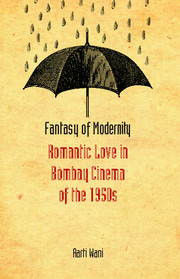Introduction
Published online by Cambridge University Press: 05 March 2016
Summary
Love and romance have been ubiquitous to Hindi cinema's narrative universe. The idiom of love inhabits all kinds of films and genres and is often considered one of Hindi cinema's essential ingredients. The ‘love interest’ generally central to films is at times peripheral; it being extremely rare to have a mainstream Hindi film without love. However, the pervasiveness of romantic love over the last five decades has been taken for granted and rarely attracted focused theoretical attention. This critical indifference to the phenomenon of love in films is even more striking in the case of the 1950s because a powerful formula centred on the trope of romantic love was consolidated during this period although its seeds were present through the earlier period of mythologicals, historicals, socials and action films. Barnouw and Krishnaswami say about the 1950s that an overwhelming number of Bombay films were centred on the chance acquaintance of the hero and heroine, who met in ‘unconventional’, ‘novel’ and ‘glamorous’ circumstances with obstacles provided by ‘villainy or accident’ and ‘not by social problems’ (Barnouw and Krishnaswami, 1980, p. 155). The role of dance and song for providing ‘conventionalized substitutes for love-making and emotional crisis’ was also noted (ibid.). Arnold Alison (1991) notes the excessive engagement with love in the songs and the lyrics from this period. Indeed the 1950s preoccupation with the trope of love is extraordinary and evident in its themes, lyrics, the visual aesthetics, and also in the publicity and gossip surrounding films and film stars. Nevertheless, the importance of romance as a ‘major signifier of this new-nation-in the making’, something that can be said to have had ‘a dim after-life after the Nehruvian era’ (Sangari, 2007, p. 278), has received little attention. In seeking to understand the meaning of romantic love in the films of the post-independence decade, this book aims to explore its wider cultural significance in the making of modernity.
- Type
- Chapter
- Information
- Fantasy of ModernityRomantic Love in Bombay Cinema of the 1950s, pp. 1 - 33Publisher: Cambridge University PressPrint publication year: 2016



